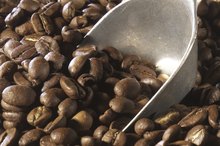What does fact checked mean?
At Healthfully, we strive to deliver objective content that is accurate and up-to-date. Our team periodically reviews articles in order to ensure content quality. The sources cited below consist of evidence from peer-reviewed journals, prominent medical organizations, academic associations, and government data.
The information contained on this site is for informational purposes only, and should not be used as a substitute for the advice of a professional health care provider. Please check with the appropriate physician regarding health questions and concerns. Although we strive to deliver accurate and up-to-date information, no guarantee to that effect is made.
Seroquel & Caffeine
Seroquel, the brand name for the anti-psychotic medication quetiapine, may be prescribed to treat schizophrenia in adults and children age 13 or older, and bi-polar disorder and adults and children age 10 or older 1. Caffeine, according to the U.S. Food and Drug Administration, is a drug and food additive that stimulates the central nervous system and increases brain activity. Consult your doctor about your caffeine habits before beginning Seroquel if you are concerned about side effects and interactions between the two substances 1.
About Seroquel
Seroquel is available as an immediate- or extended-release medication 1. According to Drugs.com, your physician’s instructions regarding your usage of Seroquel should be strictly followed to reduce the occurrence of side effects or death due to misuse 1. Do not chew, crush or break Seroquel; this can cause a rapid release of the medication, potentially leading to over-medication or a fatal overdose 1. Leave it fully intact and swallow it with a full glass of water. You may take Seroquel with or without food 1. If you experience bothersome side effects, tell your doctor immediately. Be sure to review current medications and supplements you are currently taking with your doctor before beginning Seroquel 1.
About Caffeine
Drug Interaction Between Lithium and Caffeine
Learn More
The American College of Neuropsychopharmaclogy reports that caffeine usage is more extensive than that of alcohol and nicotine, making it the "most widely consumed psychotropic drugs worldwide.” Approximately 80 percent of U.S. adults consume 200 mg of caffeine daily. It naturally occurs in 60 plants and can be found in foods, beverages, medications and dietary supplements.
Aggravated Side Effects
Patients taking Seroquel have reported feelings of anxiety and restlessness, an increased heart rate and urination frequency, gastrointestinal discomfort and difficulty falling or staying asleep 1. Excessive caffeine consumption may further exacerbate these effects. Caffeine triggers the excess production of stomach acid, or hydrochloric acid, which can aggravate acid reflux or indigestion. Because caffeine also increases the heart rate and blood pressure consuming in conjunction with Seroquel increases your risk of stroke or heart attack 1.
Redeuced Side Effects
Congestive Heart Failure & Caffeine
Learn More
You may experience drowsiness or a tired feeling when taking Seroquel, but caffeine can counteract those feelings 1. Caffeine produces feelings of alertness and wakefulness by preventing adenosine from binding with receptors, thereby, inhibiting feelings of drowsiness. Seroquel may also induce a state of mental or physical hyperactivity and impulsivity 1. In April 2000, the “Journal of Attention Disorders” published a meta-analysis, or a review of empirical or experimental studies, that found that non-medicated pediatric ADD patients showed signs of reduced hyperactivity, impulsivity and aggression.
Related Articles
References
- Drugs.com: Seroquel
- "Journal of Attention Disorders"; Effects of Caffeine on Cognitive, Psychomotor, and Affective Performance of Children With Attention-Deficit/Hyperactivity Disorder; M.Roth Leon; April 2000
- Schneider LS, Dagerman KS, Insel P. Risk of death with atypical antipsychotic drug treatment for dementia: Meta-analysis of randomized placebo-controlled trials. JAMA. 2005;294(15):1934-1943. doi:10.1001/jama.294.15.1934
Writer Bio
Meka Jones, from Cherokee, Ala., began writing in 2009. She is a faculty member at Shelton State Community College and has written for "Shoals Woman Magazine" and various online publications. Jones is pursuing a Ph.D. in exercise physiology at the University of Alabama and holds Master of Arts and Bachelor of Science degrees in physical education from the University of North Alabama.









